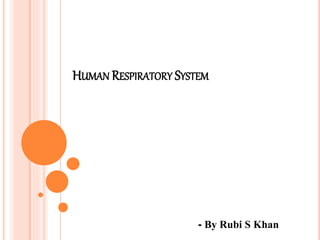
Resp-System.ppt human anatomy and physiology
- 1. HUMAN RESPIRATORY SYSTEM - By Rubi S Khan
- 2. What is the respiratory system? The respiratory system consists of the nose, pharynx , larynx, trachea, bronchi , and lungs. The primary function of this system is to furnish oxygen for individual tissue cells, and to take away the waste products and carbon dioxide produced by those same cells. The respiratory system is a biological system consisting of specific organs and structures used for gas exchange in animals and plants. The human respiratory system is a network of organs responsible for taking in oxygen and expelling carbon dioxide. Its primary organs are the lungs, which carry out this exchange of gases as we breathe.
- 3. External & internal respiration External respiration is the process of inhaling oxygen into the lungs, and exhaling carbon dioxide. Process includes the ventilation of the lungs and the exchange of air in the lungs and blood within the capillaries of the alveoli of the lungs Internal respiration is the metabolic process by which living cells use blood flowing through the capillaries, absorbing the oxygen (O2 )they need and releasing the carbon dioxide (CO2)they create.
- 5. The nose The dividing partition between the nostrils is the nasal septum, which forms two nasal cavities. Each cavity is divided into 3 air passages: the superior, middle, and inferior conchae . The external opening of the nose is the nostrils or anterior The conchae passages lead to the passageway called the pharnyx. Here, the ear is connected to the sinuses, the ears through the eustachian tubes, and even the eyes through the nasolacrimal ducts.
- 6. The Pharynx The pharynx is the correct term for the throat. It is a muscular and membranous tube that is about 5 inches long, extending downward from the base of the skull. It eventually becomes the esophagus. The nasopharynx is behind the nose. The oropharynx is behind the mouth. The laryngopharynx is behind the larynx. The pharynx also contains 3 pairs of tissues that are part of the lymphatic system: The pharynx has 3 functions: 1. serves as a passageway for air 2. serves as a passageway for food 3. aids in phonation by changing its shape. 1. the pharyngeal tonsils. 2. the palatine tonsils . 3. the lingual tonsils.
- 7. The larynx The larynx, commonly called the voice box, is located at the upper end of the trachea, below the root of the tongue and hyoid bone. It is lined with mucous membrane. Short, tense vocal cords produce high notes; long relaxed vocal cords produce low notes. The larynx contains vocal cords, which produce sound. We can see several of the cartilage structures of the larynx in this side view: The thyroid cartilage or Adam’s apple is usually larger in the male, allowing longer vocal cords and contributing to a deeper male voice
- 8. The trachea The trachea or windpipe is a smooth, muscular tube leading from the larynx to the main bronchi. The trachea is the passageway for air to and from the lungs. Trachea C-shaped rings Cartilage rings prevent crushing of the trachea It is only about 1 inch in diameter and 4 ½ inches long. Cartilage provide protection on the front and sides
- 9. The bronchi The bronchi are the two main branches at the bottom of the trachea, providing passageway for air to the lungs. The trachea divides into the right bronchus and the left bronchus, and then divides further into the bronchial tree. As the branches of the bronchial tree get smaller, the 2 primary bronchi become bronchioles, and then very small alveolar ducts. The left bronchi is smaller than the right bronchi, because room is needed to accommodate the heart. In the presence of infection, the bronchi sometimes become inflamed, resulting in a diagnosis of bronchitis.
- 10. The diaphragm The base of the lungs rest on the diaphragm, a muscular wall separating the thorax from the abdominal cavity. It is involved in respiration, drawing downward in the chest during inhalation, and pushing upward during exhalation.
- 11. The lungs The lungs are two spongy organs located in the thorax. They consist of elastic tissue, filled with an interlacing network of tubes and sacs that carry air and blood vessels. Each lung is divided into lobes, the right lung into 3 lobes and the left lung into 2. The lungs contain about 300 million alveoli sacs, which are the air cells where the exchange of oxygen and carbon dioxide takes place with the capillaries.
- 12. Vital capacity (VC) is the maximum amount of air a person can inhale after a maximum exhalation. It is equal to the sum of inspiratory reserve volume, tidal volume, and expiratory reserve volume. It is approximately equal to Forced Vital Capacity (FVC). normal adults ranges between 3 to 5 litres. Tidal volume is the amount of air that moves in or out of the lungs with each respiratory cycle. It measures around 500 mL in an average healthy adult male and approximately 400 mL in a healthy female. The inspiratory reserve volume is the amount of air a person can inhale forcefully after normal tidal volume inspiration. 1900-3300ml The expiratory reserve volume is the amount of air a person can exhale forcefully after a normal exhalation.
- 13. Respiratory diseases includes, Asthma. chronic obstructive pulmonary disease (COPD) pulmonary fibrosis pneumonia lung cancer Diseases